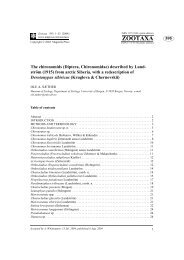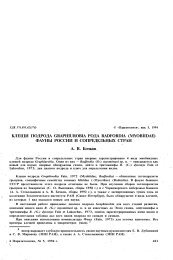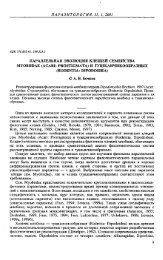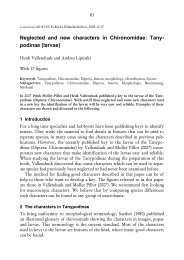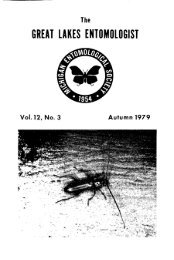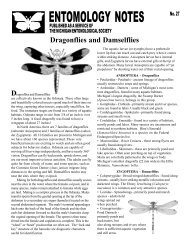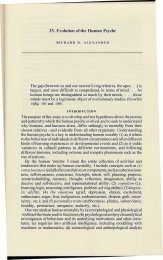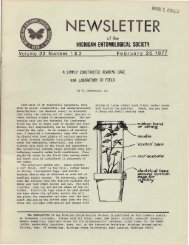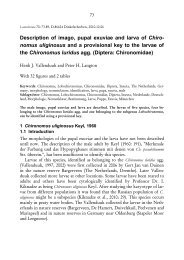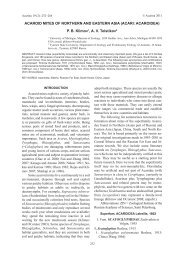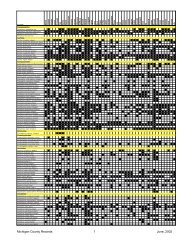acari: phytoseiidae and tydeidae - Insect Division
acari: phytoseiidae and tydeidae - Insect Division
acari: phytoseiidae and tydeidae - Insect Division
You also want an ePaper? Increase the reach of your titles
YUMPU automatically turns print PDFs into web optimized ePapers that Google loves.
Acarina 19 (1): 103–109 © Acarina 2011<br />
LIFE TABLES AND FEEDING HABITS OF PROPRIOSEIOPSIS CABONUS,<br />
A SPECIFIC PREDATOR OF TYDEID MITES<br />
(ACARI: PHYTOSEIIDAE AND TYDEIDAE)<br />
INTRODUCTION<br />
Phytoseiid mites are important biological control<br />
agents all over the world where they serve to<br />
suppress arthropod pests on cultivated <strong>and</strong> non-cultivated<br />
plants. The <strong>acari</strong>ne family Phytoseiidae includes<br />
a large number of generalist predators that<br />
can develop <strong>and</strong> reproduce using various food<br />
sources as alternatives to their primary prey, tetranychid<br />
mites (McMurtry <strong>and</strong> Croft 1997). Generalist<br />
phytoseiid mites can prey upon insects (e.g.<br />
thrips) <strong>and</strong> mites other than tetranychids (e.g. other<br />
phytoseiids, eriophyid, tydeid <strong>and</strong> tarsonemid mites<br />
(Overmeer 1985; Calis et al. 1988; Bonde 1989;<br />
Momen <strong>and</strong> Abdel-Khalek 2009), <strong>and</strong> they can also<br />
exploit honeydew <strong>and</strong> plant exudates (van Rijn <strong>and</strong><br />
Tanigoshi 1999; Gnanvossou et al. 2005).<br />
Some tydeids evidently feed to some extend<br />
on living green material, as indicated by the green<br />
body content of representatives of some species of<br />
Lorryia, Paralorryia <strong>and</strong> Tydeus (Karg 1975;<br />
Momen <strong>and</strong> Lindqvist 1995). Flaherty <strong>and</strong> Hoy<br />
(1972) evaluated the role of tydeid mites (Pronematus<br />
spp.) as suitable alternative prey for the<br />
predatory phytoseiid mite, Galendromus occidentalis<br />
(Nesbitt) (Acari: Phytoseiidae) <strong>and</strong> found<br />
that the latter would feed <strong>and</strong> reproduce on it in<br />
the laboratory. In contrast, Ferragut et al., (1987)<br />
indicated that the tydeid mite Lorryia formosa Cooreman<br />
was not a favoured prey for both phytoseiid<br />
mites, Euseius stipulatus (Athias-Henriot)<br />
<strong>and</strong> Typhlodromus phialatus Athias-Henriot. Research<br />
by Camporese <strong>and</strong> Duso (1995) as well as<br />
Zaher et al. (2001) revealed that Tydeus caudatus<br />
Duges <strong>and</strong> Tydeus californicus (Banks) (both Acari:<br />
Tydeidae) were the primary food for the phy-<br />
F. M. MOMEN<br />
Pests <strong>and</strong> Plant Protection Department, National Research Centre, 31 El-Tahrir Street, 12322 Dokki,<br />
Cairo, Egypt; e-mail: fatmomen@yahoo.com<br />
ABSTRACT: Biology, life table parameters <strong>and</strong> predation rates of the predatory mite Proprioseiopsis cabonus (Schicha <strong>and</strong><br />
Elshafie) (Acari: Phytoseiidae) feeding on nymphs of Neoapolorryia aegyptiaca El Bagoury <strong>and</strong> Momen <strong>and</strong> Lorryia aegyptiaca<br />
(Rasmy <strong>and</strong> El Bagoury) (both Acari: Tydeidae), Ricinus communis L. (castor bean) pollen <strong>and</strong> Phoenix dactylifera L. (date palm)<br />
pollen were studied at 30 ± 1ºC, 70 ± 5% RH <strong>and</strong> photoperiod of 16: 8 (L:D) hours. Total developmental time of P. cabonus females<br />
was 9.9 <strong>and</strong> 11.1 days on nymphs of N. aegyptiaca <strong>and</strong> L. aegyptiaca. Survival of immatures of P. cabonus was very low on both<br />
pollen grains <strong>and</strong> all failed to develop to adulthood. A total of 47.6 <strong>and</strong> 40.8 eggs per female, respectively, were obtained when P.<br />
cabonus was fed on nymphs of above tydeid mites. Life table parameters were estimated as net reproductive rate (Ro) 35.95 <strong>and</strong><br />
24.64, intrinsic rate of increase (r m ) 0.213 <strong>and</strong> 0.174 days -1 , finite rate of increase (λ) 1.236 <strong>and</strong> 1.190, mean generation time (T)<br />
16.9 <strong>and</strong> 18.4 days <strong>and</strong> doubling time (DT) 3.2 <strong>and</strong> 3.9 days when the predator fed on nymphs of N. aegyptiaca <strong>and</strong> L. aegyptiaca.<br />
Average daily predation of P. cabonus females on N. aegyptiaca <strong>and</strong> L. aegyptiaca nymphs was 25.6 <strong>and</strong> 20.3.<br />
KEY WORDS: Acari, life table, Phytoseiidae, pollen grains, Tydeidae<br />
103<br />
toseiid mite, Paraseiulus talbii (Athias-Henriot).<br />
Ueckermann <strong>and</strong> Grout (2007) suggested that both<br />
tydeid mites, T. californicus <strong>and</strong> Pronematus<br />
ubiquitus (McGregor) probably serve as prey for<br />
various predatory mites on citrus in many parts of<br />
the world.<br />
Phytoseiid mites of the genus Proprioseiopsis<br />
spp. have been found in ground surface litter or on<br />
grass (Muma <strong>and</strong> Denmark 1970). Very little is<br />
known about the biology of this genus, P. temperellus<br />
(Muma <strong>and</strong> Denmark) was fed Tetranychus<br />
urticae Koch (Acari: Tetranychidae) eggs alone at<br />
various temperatures (Ball 1980), P. mexicanus<br />
(Garman) population increase when fed T. urticae<br />
eggs (Megev<strong>and</strong> et al. 1993), P. rotundus (Muma)<br />
fed on all stages of T. urticae <strong>and</strong> pollen of various<br />
plants (Abou-Setta et al. 1997), P. asetus (Chant)<br />
was fed Eutetranychus orientalis (Klein) (Acari:<br />
Tetranychidae) or T. urticae (Fouly 1997). Recently,<br />
Lawson-Balagbo et al. (2008) demonstrated<br />
the presence of P. canaensis on attached coconuts,<br />
leaflets <strong>and</strong> fallen coconuts leaflets <strong>and</strong> fallen<br />
coconuts in northern <strong>and</strong> northeastern Brazil,<br />
probably feeding on Aceria guerreronis Keifer<br />
(Acari: Eriophyidae). Also, Emmert et al. (2008)<br />
determined the intrinsic rate of increase for P. asetus<br />
when fed cattail pollen Typha latifolia L., T.<br />
urticae <strong>and</strong> Frankliniella occidentalis (Perg<strong>and</strong>e)<br />
(family: Thripidae). From the perusal of the literature,<br />
nothing is known about the biology of Proprioseiopsis<br />
cabonus (Schicha <strong>and</strong> Elshafie), with<br />
the exception of Momen (1999, 2009) <strong>and</strong> Momen<br />
<strong>and</strong> El-Borolossy (1999), whom reported that the<br />
predator failed to feed <strong>and</strong> develop on eggs <strong>and</strong>
nymphs of T. urticae as well as nymphs of E. orientalis<br />
<strong>and</strong> the grass eriophyid mite Aceria dioscoridis<br />
(Soliman <strong>and</strong> Abou-Awad).<br />
The objective of this study was to predict the<br />
relative nutritional value of Ricinus communis L.<br />
(castor bean) pollen (Euphorbiaceae), Phoenix dactylifera<br />
L. (date palm) pollen (Arecaceae), nymphs<br />
of Neoapolorryia aegyptiaca El Bagoury <strong>and</strong><br />
Momen <strong>and</strong> Lorryia aegyptiaca (Rasmy <strong>and</strong> El Bagoury)<br />
(both Acari: Tydeidae) to the predatory mite<br />
P. cabonus, in order to make a preliminary evaluation<br />
to their potential role as food. In particular, the<br />
survival as well as the reproductive potential of the<br />
phytoseiid mite was evaluated <strong>and</strong> compared, under<br />
laboratory conditions, using the above diets.<br />
MATERIALS AND METHODS<br />
Host <strong>and</strong> phytoseiid predatory mite culture<br />
Adult females of P. cabonus were obtained<br />
from soil associated with roots of Pelargonium<br />
graveolens Ait at Tanta Governorate in January<br />
2009. The stock cultures of P. cabonus were maintained<br />
using N. aegyptiaca as the food source.<br />
Feeding experiments were conducted in the laboratory<br />
at 30 ± 1ºC <strong>and</strong> 70 ± 5% RH, in arenas (3×3<br />
cm) of excised raspberry leaves, placed on water-<br />
saturated cotton in plastic Petri-dishes. Females<br />
were left 24-h <strong>and</strong> eggs laid were used for the subsequent<br />
experiments.<br />
Diets<br />
Four diets were evaluated for their effect on<br />
development, survival, fecundity <strong>and</strong> life-table<br />
parameters.<br />
1. Nymphs of N. aegyptiaca, were found in soil<br />
associated with roots of P. graveolens.<br />
2. Nymphs of L. aegyptiaca, were collected from<br />
debris under palm trees surrounding the farm where<br />
P. graveolens is cultivated.<br />
Both tydeid mites were extracted with an extraction<br />
apparatus as described by Cusack, Evans<br />
<strong>and</strong> Brennan (1975) every 2 days as food for P.<br />
cabonus <strong>and</strong> various biological data.<br />
3. Castor bean R. communis pollen<br />
4. Date palm P. dactylifera pollen<br />
Pollen collected from R. communis <strong>and</strong> P.<br />
dactylifera was poured into vials <strong>and</strong> stored at 4ºC<br />
before being applied to clean raspberry discs.<br />
Effect of diets on the development, prey consumption<br />
<strong>and</strong> survival rates of the predatory<br />
mite P. cabonus<br />
Predator eggs were r<strong>and</strong>omly chosen <strong>and</strong> placed<br />
singly on the rearing disc, <strong>and</strong> the newly hatched lar-<br />
F. M. Momen<br />
104<br />
vae were supplied with six nymphs of each of N. aegyptiaca<br />
<strong>and</strong> L. aegyptiaca or each arena was supplied<br />
with a small amount of P. dactylifera <strong>and</strong> R.<br />
communis pollen grains <strong>and</strong> was replaced at 48–72<br />
hours intervals. Replacement of the mite prey was<br />
carried out daily <strong>and</strong> records of development, survival,<br />
prey consumption <strong>and</strong> reproduction were recorded<br />
twice a day. Observations made were: incubation<br />
period of the egg stage, duration of larval,<br />
protonymphal <strong>and</strong> deutonymphal stages <strong>and</strong> survival<br />
rate. A male P. cabonus was introduced to<br />
each leaf disc with a deutonymph just before it<br />
moulted to become a female. After copulation, the<br />
male was removed. Every 5–6 days, a new male was<br />
introduced to fertilize female for repeated mating.<br />
Effect of diets on the fecundity, prey consumption,<br />
longevity <strong>and</strong> life table statistics of<br />
the predatory mite P. cabonus<br />
Newly emerged mated females of P. cabonus<br />
were confined individually to test arenas (as described<br />
above) <strong>and</strong> were provided daily with sufficient<br />
number of tydeid nymphs. Daily observations<br />
were made to determine the pre-oviposition,<br />
oviposition <strong>and</strong> post-oviposition periods as well<br />
as to gather data on consumption rate, fecundity<br />
<strong>and</strong> sex ratio of offspring <strong>and</strong> mortality.<br />
Statistical analysis<br />
A Student's t-test was used to test the effects<br />
of N. aegyptiaca <strong>and</strong> L. aegyptiaca nymphs on<br />
various developmental parameters of P. cabonus.<br />
Assessment of significance was taken at 0.05 <strong>and</strong><br />
0.01 level probabilities.<br />
Life table<br />
The life-history data for P. cabonus (n = 16 for<br />
N. aegyptiaca <strong>and</strong> n = 15 for L. aegyptiaca) obtained<br />
from daily observations of immature stages<br />
<strong>and</strong> adults were used to construct the life table for<br />
the predator. Life table parameters were calculated<br />
using the method recommended by Birch (1948).<br />
The life table statistics were calculated using software<br />
developed by Abou-Setta et al. (1986).<br />
The life table parameters were calculated as<br />
follows:<br />
— The age specific survival (L x )<br />
— The age specific fecundity (m x ) = born female/<br />
female<br />
— The net reproductive value (R o ) = ∑ (L x m x )<br />
(Birch 1948)<br />
— The intrinsic rate of increase (r m ) which is calculated<br />
by iteratively solving the Euler equation,<br />
∑ (e - rm x L x m x ) = 1 (Birch 1948)
Life tables <strong>and</strong> feeding habits of Proprioseiopsis cabonus, a specific predator of tydeid mites<br />
Table 1<br />
Comparative duration (Mean ± SE in days) of female stages of Proprioseiopsis cabonus fed on nymphs<br />
of Neoapolorryia aegyptiaca <strong>and</strong> Lorryia aegyptiaca at 30ºC <strong>and</strong> 75% RH<br />
Developmental stages<br />
Prey species<br />
N. aegyptiaca L. aegyptiaca<br />
hRo<br />
— The mean generation time (T) =<br />
(Birch 1948)<br />
r m<br />
— The finite rate of increase (λ) = e rm<br />
N. aegyptiaca <strong>and</strong> L. aegyptiaca, while the predator<br />
failed to develop beyond the protonymphal<br />
stage when offered pollen grains of P. dactylifera<br />
(Birch 1948)<br />
<strong>and</strong> R. communis (Table 1).<br />
The larvae of P. cabonus moult to proto-<br />
h2<br />
nymphal stage without feeding. The consumption<br />
— The doubling time (Dt) =<br />
(Kairo <strong>and</strong> Murphy 1995) r m<br />
rate increased through the developmental stages<br />
respectively (Table 2).<br />
— Gross reproductive rate (GRR) ∑ mx The immature stages of P. cabonus consumed<br />
RESULTS<br />
Effect of diets on the development, prey consumption<br />
<strong>and</strong> survival rate of the predatory<br />
mite P. cabonus<br />
more N. aegyptiaca nymphs than L. aegyptiaca<br />
nymphs (T = 4.543, p = 0.000). Development<br />
(egg-adult female) was significantly faster on a<br />
diet of N. aegyptiaca nymphs than on a diet of L.<br />
aegyptiaca nymphs (T = 3.796; p = 0.001) (Table<br />
Individuals of P. cabonus successfully devel- 1). Survival was (100%) when fed N. aegyptiaca<br />
oped from larva to adult when fed on nymphs of than L. aegyptiaca (96%), respectively.<br />
105<br />
T (value) Probability (at 0.05 <strong>and</strong> 0.01)<br />
Egg 2.19 ± 0.10 2.27 ± 0.12 0.512 0.613<br />
Larva 1.44 ± 0.13 1.67 ± 0.12 1.273 0.213<br />
Protonymph 3.06 ± 0.14 3.54 ± 0.13 2.396 * 0.023<br />
Deutonymph 3.25 ± 0.11 3.60 ± 0.13 2.041 0.050<br />
Total life cycle 9.93 ± 0.21 11.07 ± 0.21 3.796 ** 0.001<br />
% Reaching maturity 100 96<br />
Pre-oviposition period 2.43 ± 0.13 2.33 ± 0.12 0.579 0.567<br />
Oviposition period 23.56 ± 0.49 21.93 ± 0.48 2.361 * 0.025<br />
Post-oviposition period 8.87 ± 0.26 5.60 ± 0.41 6.848 ** 0.000<br />
Adult longevity 34.87 ± 0.55 29.87 ± 0.65 5.905 ** 0.000<br />
Life span 44.81 ± 0.63 40.93 ± 0.61 4.389 ** 0.000<br />
* P≤ 0.05; ** P≤ 0.01<br />
* Significant, ** highly significant<br />
Table 2<br />
Average consumption rate (Mean ± SE) per day of Proprioseiopsis cabonus fed on nymphs of Neoapolorryia<br />
aegyptiaca <strong>and</strong> Lorryia aegyptiaca at 30ºC <strong>and</strong> 75% RH<br />
Stages of P. cabonus<br />
Prey species<br />
N. aegyptiaca L. aegyptiaca<br />
T (value) Probability (at 0.05 <strong>and</strong> 0.01)<br />
Larva Non feeding Non feeding – –<br />
Protonymph 3.37 ± 0.12 3.13 ± 0.16 1.176 NS 0.249<br />
Deutonymph 6.12 ± 0.34 4.07 ± 0.21 5.092 ** 0.000<br />
Total life cycle 9.50 ± 0.41 7.00 ± 0.35 4.543 ** 0.000<br />
Pre-Oviposition period 3.43 ± 0.24 3.13 ± 0.16 1.028 NS 0.313<br />
Oviposition period 16.06 ± 0.65 12.73 ± 0.57 3.805 ** 0.001<br />
Post-oviposition period 6.06 ± 0.42 4.40 ± 0.32 3.101 ** 0.004<br />
Adult longevity 25.56 ± 0.75 20.27 ± 0.67 5.222 ** 0.000<br />
** Highly significant, Ns: not significant
F. M. Momen<br />
Table 3<br />
Life table parameters of Proprioseiopsis cabonus fed on nymphs of Neoapolorryia aegyptiaca <strong>and</strong><br />
Lorryia aegyptiaca at 30ºC <strong>and</strong> 75% RH<br />
Life table parameters<br />
Effect of diets on the fecundity, prey consumption,<br />
longevity <strong>and</strong> life table statistics of<br />
the predatory mite P. cabonus<br />
The pre-oviposition period was likewise for<br />
P. cabonus fed on both tydeid mites. Proprioseiopsis<br />
cabonus had significantly longer oviposition<br />
<strong>and</strong> highly significantly post-oviposition periods<br />
<strong>and</strong> adult longevity when fed on nymphs of N. aegyptiaca<br />
(23.56, 8.87 <strong>and</strong> 34.87 days) than on<br />
nymphs of L. aegyptiaca (21.93, 5.60 <strong>and</strong> 29.87<br />
days), respectively (Table 1). Adult females of P.<br />
cabonus consumed more of both tydeid nymphs<br />
during the oviposition periods than on pre-oviposition<br />
or post-oviposition periods, respectively<br />
(Table 2). The highest rate of oviposition was recorded<br />
on nymphs of N. aegyptiaca (47.62 eggs /<br />
female), <strong>and</strong> the lowest on nymphs of L. aegyptiaca<br />
(40.80 eggs / female) (Table 3).<br />
Table (3) summarizes the effect of N. aegyptiaca<br />
<strong>and</strong> L. aegyptiaca nymphs as natural /alternative<br />
food on the life table parameters of P. cabonus.<br />
The age-specific survival rate L x (percent of<br />
surviving females at the instant x) <strong>and</strong> the agespecific<br />
fecundity rate m x (number of female eggs<br />
laid per female per day) for P. cabonus reared on<br />
N. aegyptiaca <strong>and</strong> L. aegyptiaca are shown in Fig.<br />
(1). The intrinsic rate of natural increase (r m ) of P.<br />
cabonus increased from 0.1742 on L. aegyptiaca<br />
to 0.2126 on N. aegyptiaca. Similarly the net reproductive<br />
rate (R o ) increased from 24.64 times<br />
per individual per generation on L. aegyptiaca to<br />
35.953 times per individual per generation on N.<br />
aegyptiaca (Table 3). The mean generation time<br />
ranged between (16.84 <strong>and</strong> 18.38 days), the dou-<br />
106<br />
Prey<br />
N. aegyptiaca L. aegyptiaca<br />
Net reproductive rate (R o ) 35.95313 24.64<br />
Intrinsic rate of increase (r m ) 0.2126064 0.174252<br />
Finite rate of increase (λ) 1.236898 1.190356<br />
Mean generation time (T) 16.84905 18.38924<br />
Doubling time (DT) 3.237 3.977<br />
Gross reproductive rate (GRR) 38.45 26.05<br />
** Mean total number of eggs deposited per female 47.62 ± 0.96 a 40.80 ± 0.66 b<br />
* Mean daily number of eggs deposited per female 2.03 ± 0.06 a 1.84 ± 0.04 b<br />
Sex ratio (F/ F+M) 0.75 0.6<br />
Different letters in a transverse row denote a significant difference (T-test for total number of eggs deposited / female = 5.807 ** ,<br />
p = 0.000; T-test for daily number of eggs deposited / female = 2.672 * , df = 29), p = 0.12<br />
* Significant, ** Highly significant<br />
bling time (Dt) was 3.23 <strong>and</strong> 3.97 while the gross<br />
reproductive rate (GRR) was 38.45 <strong>and</strong> 26.05, respectively<br />
when the predator was fed nymphs of<br />
N. aegyptiaca <strong>and</strong> L. aegyptiaca. The sex ratio of<br />
the progeny was strongly female biased when females<br />
of P. cabonus were fed N. aegyptiaca<br />
nymphs (female / total = 0.75).<br />
DISCUSSION<br />
Proprioseiopsis cabonus is found in soil under<br />
P. graveolens in some areas of Egypt in association<br />
with different Acari <strong>and</strong> insects, including<br />
N. aegyptiaca, L. aegyptiaca, T. caudatus (all Acari:<br />
Tydeidae). Tydeid mites appeared to be suitable<br />
as prey for P. cabonus. Feeding habits of P.<br />
cabonus: a comparison with other species of the<br />
genus Proprioseiopsis in the family Phytoseiidae<br />
are possible. The feeding habits of the P. cabonus<br />
appear to be substantially different from those of<br />
the most common members of the genus Proprioseiopsis<br />
found in soil surface litter or on grass (e.<br />
g. P. temperelus, P. cannaensis <strong>and</strong> P. rotundus).<br />
Development <strong>and</strong> reproduction failed when fed on<br />
R. communis <strong>and</strong> P. dactylifera pollen grains<br />
which were efficient for rearing P. cannaensis <strong>and</strong><br />
P. rotundus (Abou-Setta et al. 1997). Pollen grains<br />
vary in their chemical composition <strong>and</strong> not all pollen<br />
types are efficient food for phytoseiids (Mc-<br />
Murtry <strong>and</strong> Rodriguez 1987). Spider <strong>and</strong> eriophyid<br />
mites were never associated with P. cabonus <strong>and</strong><br />
also were not favoured food for rearing the predator<br />
since high mortality rates were recorded on<br />
these prey (Momen 1999, 2009). In contrast, T.<br />
urticae <strong>and</strong> E. orientalis were favoured by P. tem-
Female progeny/female/day (Mx)<br />
Female progeny/female/day (Mx)<br />
2,5<br />
2<br />
1,5<br />
1<br />
0,5<br />
0<br />
1,6<br />
1,4<br />
1,2<br />
1<br />
0,8<br />
0,6<br />
0,4<br />
0,2<br />
0<br />
Life tables <strong>and</strong> feeding habits of Proprioseiopsis cabonus, a specific predator of tydeid mites<br />
1 6 11 16 21 26<br />
Mite age (days)<br />
1 6 11 16 21 26<br />
Mite age (days)<br />
perellus, P. mexicanus, P. asetus <strong>and</strong> P. canaensis<br />
(Ball 1980; Megev<strong>and</strong> et al. 1993, Lawson-Balagbo<br />
et al. 2008). The feeding behavior of P. cabonus is<br />
similar to that of P. talbii since tetranychid <strong>and</strong><br />
eriophyid mites as well as date palm <strong>and</strong> castor oil<br />
pollen grains were also unsuitable diet for the predator,<br />
while it successfully developed on tydeid<br />
mites (Camporese <strong>and</strong> Duso 1995; Zaher 2001).<br />
Nassar (1976) also indicated that T. californicus<br />
was more suitable prey for the cunaxid mite Cunaxa<br />
setirostris (Hermann) (Acari: Cunaxidae) than<br />
tetranychids <strong>and</strong> tenuipalpids. In the present work,<br />
development was successful on both tydeid mites<br />
107<br />
1,2<br />
1<br />
0,8<br />
0,6<br />
0,4<br />
0,2<br />
0<br />
Survivalship (Lx)<br />
N. aegyptiaca<br />
Mx<br />
L. aegyptiaca<br />
Fig.1. Age-specific fecundity (Mx) <strong>and</strong> survivorship (Lx) of Proprioseiopsis cabonus reared on Neoapolorryia aegyptiaca <strong>and</strong><br />
Lorryia aegyptiaca<br />
1,2<br />
1<br />
0,8<br />
0,6<br />
0,4<br />
0,2<br />
0<br />
Survivalship (Lx)<br />
Mx<br />
<strong>and</strong> developed more rapidly on N. aegyptiaca than<br />
on L. aegyptiaca. The preference of tydeids over<br />
tetranychids, eriophyids <strong>and</strong> pollen grains by P. cabonus<br />
constitutes the most important difference in<br />
feeding habits between this predator <strong>and</strong> the above<br />
— mentioned Proprioseiopsis species. Suitability<br />
of soil tydeid mites (associated with P. cabonus) as<br />
a prey may be due to the small size, soft body <strong>and</strong><br />
tendency to aggregate in clusters, characteristics<br />
that make N. aegyptiaca <strong>and</strong> L. aegyptiaca easier to<br />
attack. Moreover, these species might have kairomones<br />
that attract the predator. The reason for the<br />
unsuitability of tetranychid mites for the phytosei-<br />
Lx<br />
Lx
id predators is unknown, but might be attributed to<br />
the mouthparts of the predatory not adapted to<br />
rupture the cuticle of larger prey or the webbing<br />
produced by spider mites.<br />
Indeed, some phytoseiid predators are specialist,<br />
while others are generalist (McMurtry <strong>and</strong><br />
Croft 1997). The feeding habits of P. cabonus are<br />
similar to those of two other phytoseiid species:<br />
Typhlodromina conspicuous (Garman) was abundant<br />
on avocado in California <strong>and</strong> associated with<br />
the primarily prey T. californicus (Fleschner <strong>and</strong><br />
Ricker 1954). Paraseiulus talbii occurs in vineyards<br />
<strong>and</strong> mango orchards were reported to be a<br />
specific predator of T. caudatus <strong>and</strong> T. californicus<br />
(Comprese <strong>and</strong> Duso 1995; Zaher et al. 2001).<br />
Life history parameters were more favorable for<br />
P. cabonus on a N. aegyptiaca diet compared to a<br />
L. aegyptiaca diet. This is confirmed by the net<br />
reproductive rate which was 1.5 times higher on<br />
N. aegyptiaca than on L. aegyptiaca. Fouly (1997)<br />
also reported a greater mean generation time (T)<br />
<strong>and</strong> lower net reproductive rate (R o ) for P. asetus<br />
at 26ºC on Polyphagotarsonemus latus (Banks)<br />
(Acari: Tarsonemidae). Zaher et al. (2001) reported<br />
lower (R o ) <strong>and</strong> higher (r m ) values of P. talbii<br />
feeding on T. californicus at 32ºC. Prey consumption<br />
is broadly defined as prey captured, killed <strong>and</strong><br />
fed upon, because the volume of fluids extracted<br />
from a prey can vary considerably depending on<br />
duration of feeding on an individual prey (Mc-<br />
Murtry <strong>and</strong> Rodriguez 1987). Proprioseiopsis cabonus<br />
immatures killed 7.0–9.5 nymphs per day<br />
of both tydeid mites to reach adulthood, <strong>and</strong> increased<br />
to 20.27–25.56 nymphs per day during<br />
female stages. This number of consumed prey was<br />
higher than that reported for P. talbii (4.83 <strong>and</strong> 8.6<br />
nymphs of T. californicus) killed per day at similar<br />
temperature <strong>and</strong> humidity (Zaher et al. 2001).<br />
CONCLUSION<br />
This study indicated that P. cabonus developed<br />
<strong>and</strong> reproduced successfully on tydeid mites,<br />
N. aegyptiaca <strong>and</strong> L. aegypticae. Muma (1971) divided<br />
c<strong>and</strong>idate food offered to various female<br />
phytoseiids in the laboratory into four categories:<br />
optimal, adequate, survival <strong>and</strong> inadequate foods.<br />
According to these criteria, food tested in the present<br />
work could be divided as follows: optimal food<br />
(both tydeid mites tested) <strong>and</strong> inadequate food<br />
(both pollen grains tested). I would suggest further<br />
studies on the predatory impact <strong>and</strong> responses of<br />
P. cabonus to various mite <strong>and</strong> insect species associated<br />
with the predator in its habitat.<br />
F. M. Momen<br />
108<br />
REFERENCES<br />
Abou-Setta, M.M., Fouly, A.H. <strong>and</strong> Childers, C.C.<br />
1997. Biology of Proprioseiopsis asetus (Acari:<br />
Phytoseiidae) reared on Tetranychus urticae (Acari:<br />
Tetranychidae) <strong>and</strong> on pollen. Florida Entomologist,<br />
80: 27–33.<br />
Abou-Setta, M.M., Sorrell, R.W. <strong>and</strong> Childers, C.C.<br />
1986. Life 48: A BASIC computer program to calculate<br />
life table parameters for an insect or mite<br />
species. Florida Entomologist, 69: 690–697.<br />
Ball, J.C. 1980. Development, fecundity <strong>and</strong> prey consumption<br />
of four species of phytoseiid mites (Phytoseiidae)<br />
at two constant temperatures. Environmental<br />
Entomology, 9: 298–303.<br />
Birch, L.C. 1948. The intrinsic rate of natural increase<br />
of an insect population. Journal of Animal Ecology,<br />
17: 15–26.<br />
Bonde, J. 1989. Biological studies including population<br />
growth parameters of the predatory mite Amblyseius<br />
barkeri (Acarina: Phytoseiidae) at 25ºC in<br />
the laboratory. Entomophaga, 34: 275–287.<br />
Calis, J.N.M., Overmeer, W.P.J. <strong>and</strong> van der Geest,<br />
L.P.S. 1988. Tydeids as alternative prey for phytoseiid<br />
mites in apple orchards. Mededelingen van<br />
de Facultetit L<strong>and</strong>bouwwetenschappen, Rijksuniversiteit<br />
Gent (Belgium), 53: 793–798.<br />
Camporese, P. <strong>and</strong> Duso, C. (1995). Life history <strong>and</strong><br />
life table parameters of the predatory mite Typhlodromus<br />
talbii. Entomologia Experimentalis et Applicata,<br />
77: 149–157.<br />
Cusak, P.D., Evans, G.O. <strong>and</strong> Brennan, P.A. 1975. A<br />
survey of the mites of stored grain <strong>and</strong> grain products<br />
in the Republic of Irel<strong>and</strong>. The Scientific Proceeding<br />
of the Royal Dublin Society, B (3): 273–<br />
329.<br />
Emmert, C.J., Mizell, R.F., Andersen, P.C., Frank, J.H.<br />
<strong>and</strong> Stimac, J.L. 2008. Diet effects on Intrinsic<br />
rate of increase <strong>and</strong> rearing of Proprioseiopsis<br />
asetus (Acari: Phytoseiidae). Annals of the Entomological<br />
Society of America, 101: 1033–1040.<br />
Ferragut, F., Garcia-Mari, F., Costa-Comelles, J. <strong>and</strong><br />
Laborda, R. 1987. Influence of food <strong>and</strong> temperature<br />
on development <strong>and</strong> oviposition of Euseius<br />
stipulatus <strong>and</strong> Typhlodromus phialatus (Acari:<br />
Phytoseiidae). Experimental <strong>and</strong> Applied Acarology,<br />
3: 317–329.<br />
Flaherty, D.L. <strong>and</strong> Hoy, M.A. 1972 Biological control of<br />
pacific mites <strong>and</strong> willamette mites in San Joaquin<br />
Valley vineyards: Part III. Role of tydeid mites. Research<br />
of Population Ecology, 13: 80–96.<br />
Fleschner, C.A. <strong>and</strong> Ricker, D.W. 1954. Typhlodromid<br />
mites on citrus <strong>and</strong> avocado trees in southern California.<br />
Journal of Economic Entomology, 47:<br />
356–357.<br />
Fouly, A.H. 1997. Effects of prey mites <strong>and</strong> pollen on<br />
the biology <strong>and</strong> life tables of Proprioseiopsis asetus<br />
(Chant) (Acari: Phytoseiidae). Journal of Applied<br />
Entomology, 121: 435–439.
Life tables <strong>and</strong> feeding habits of Proprioseiopsis cabonus, a specific predator of tydeid mites<br />
Gnanvossou, D., Hanna, R., Yaninek, J.S., <strong>and</strong> Toko,<br />
M. 2005. Comparative life history traits of three<br />
neotropical phytoseiid mite species when feeding<br />
on plant-derived food. Biological Control, 35:<br />
32–39.<br />
Kairo, M.T.K. <strong>and</strong> Murphy, S.T. 1995. The life history<br />
of Rodolia iceryae Janson (Coleoptera: Coccinellidae)<br />
<strong>and</strong> the potential for use in innoculative release<br />
against Icerya pattersoni Newstead (Homoptera:<br />
Margarodidae) on coffee. Journal of<br />
Applied Entomology, 119: 487–491.<br />
Karg, W. 1975. Zur Kenntnis der Tydeiden (Acarina,<br />
Trombidiformes) aus Apfelanlagen. Zoologischer<br />
Anzeiger, 194: 91–110.<br />
Lawson-Balagbo, L.M., Gondim Jr, M.G.C., de Moraes,<br />
G.J., Hanna, R., <strong>and</strong> Schausberger, P. 2008.<br />
Exploration of the <strong>acari</strong>ne fauna on coconut palm<br />
in Brazil with emphasis on Aceria guerreronis<br />
(Acari: Eriophyidae) <strong>and</strong> its natural enemies. Bulletin<br />
of Entomological Research, 98: 83–96.<br />
Megev<strong>and</strong>, B., Klay, A., Gnanvossou, D. <strong>and</strong> Paraiso,<br />
G. 1993. Maintenance <strong>and</strong> mass rearing of phytoseiid<br />
predators of the cassava green mite. Experimental<br />
<strong>and</strong> Applied Acarology, 17: 115–128.<br />
McMurtry, J.A. <strong>and</strong> Croft, B.A. 1997. Life-styles of<br />
phytoseiid mites <strong>and</strong> their roles in biological control.<br />
Annual Review of Entomology, 42: 291–321.<br />
McMurtry, J.A. <strong>and</strong> Rodriguez, J.G. 1987. Nutritional<br />
ecology of phytoseiid mites. In: F. Slansky <strong>and</strong><br />
J.G. Rodriguez (eds.) Nutritional ecology of insects,<br />
mites, spiders <strong>and</strong> related invertebrates. Wiley,<br />
New York, pp. 609–644.<br />
Momen, F.M. 1999. Feeding behaviour of some phytoseiid<br />
predators on the two spotted spider mite eggs<br />
(Acari: Phytoseiidae, Tetranychidae). Phytophaga,<br />
9: 85–92.<br />
Momen, F.M. 2009. Life history of predatory mites<br />
Typhlodromus athiasae <strong>and</strong> Amblyseius cabonus<br />
(Acari: Phytoseiidae) on two pest mites as prey,<br />
with special reference to Eriophyes dioscoridis<br />
(Acari: Tydeidae). Archives of Phytopathology<br />
<strong>and</strong> Plant Protection, 42: 1088–1095.<br />
Momen, F. <strong>and</strong> Abdel-Khalek, A. 2009. Cannibalism<br />
109<br />
<strong>and</strong> intraguild predation in the phytoseiid mites<br />
Typhlodromips swirskii, Euseius scutalis <strong>and</strong><br />
Typhlodromus athiasae (Acari: Phytoseiidae). Acarina,<br />
17 : 223–229.<br />
Momen, F.M. <strong>and</strong> El-Borolossy, M.E. 1999: Suitability<br />
of the citrus brown mite, Eutetranychus orientalis<br />
as prey for nine species of phytoseiid mites (Acari:<br />
Tetranychidae: Phytoseiidae). Acarologia, 40:<br />
19–30.<br />
Momen, F.M. <strong>and</strong> Lundqvist, L. 1995: The genus Tydeus<br />
(Acari :Prostigmata: Tydeidae) in Southern<br />
Sweden. Six new species. Acarologia, 36: 41–56.<br />
Muma, M.H. 1971. Food habits of Phytoseiidae (Acarina:<br />
Mesostigmata) including common species<br />
on Florida citrus. Florida Entomologist, 54: 21–<br />
34.<br />
Muma, M.H. <strong>and</strong> Denmark, H.A. 1970. Phytoseiidae of<br />
Florida. Arthropods of Florida <strong>and</strong> neighboring<br />
l<strong>and</strong> areas, vol. 6. Florida Department of Agriculture<br />
<strong>and</strong> Consumer Services, <strong>Division</strong> of Plant Industries,<br />
Gainesville, Florida.<br />
Nassar, O.A. 1976. Incidence of predacious mites on<br />
fruits trees in North East of Deleta, with emphasis<br />
on Cunaxa setirostris (Hermann). M. SC. Thesis,<br />
Faculty of Agriculture, Cairo University.<br />
Overmeer, W.P.J. 1985. The Phytoseiidae. Alternative<br />
prey <strong>and</strong> other food sources. In: W. Helle <strong>and</strong><br />
M.W. Sabelis (eds.) Spider mites, their biology,<br />
natural enemies <strong>and</strong> <strong>and</strong>control. Vol. 1B Elsevier,<br />
Amsterdam, Oxford, New York, pp. 131–139.<br />
van Rijn, P.C.J. <strong>and</strong> Tanigoshi, L.K. 1999. Pollen as<br />
food for the predatory mites Iphiseius degenerans,<br />
Neoseiulus cucumeris (Acari: Phytoseiidae): dietary<br />
range <strong>and</strong> life history. Experimental <strong>and</strong> Applied<br />
Acarology, 23: 785–802.<br />
Ueckermann, E.A. <strong>and</strong> Grout, T.G. 2007. Tydeoid<br />
mites (Acari: Tydeidae, Edbakerellidae, Iolinidae)<br />
occurring on Citrus in southern Africa. Journal of<br />
Natural History, 41: 2351–2378.<br />
Zaher, M.A., El-Borolossy, M.A. <strong>and</strong> Ali, F.S. 2001.<br />
Morphological <strong>and</strong> biological studies on Typhlodromus<br />
talbii Athias-Henriot (Gamasida: Phytoseiidae).<br />
<strong>Insect</strong> Science et Applicata, 21: 43–53



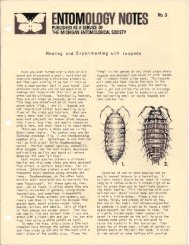
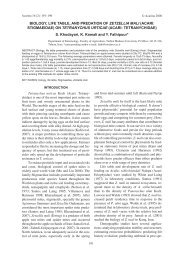
![Williamsonia 1-1 [v4.0] (DR) - Insect Division - University of Michigan](https://img.yumpu.com/18248489/1/190x245/williamsonia-1-1-v40-dr-insect-division-university-of-michigan.jpg?quality=85)
